I am installing a RHODAN 36 volt trolling motor on the bow of my Glacier Bay cat. I am going to use 3x 12v flooded cell group 24 batteries. I want to locate them a little aft of midships so the cable run is about 14 feet. I would rather have a little extra length than have tight runs with no chance for rearranging things, so maybe 16 fee total. The specs call out 42 amps to achieve the full 120 pounds of thrust. I am wondering if #6 AWG is big enough? If I am off base here, please line me up.
You are using an out of date browser. It may not display this or other websites correctly.
You should upgrade or use an alternative browser.
You should upgrade or use an alternative browser.
Help me figure the AWG wire for my trolling motor
- Thread starter Halfhitch
- Start date
Sardinia306Canyon
GreatGrady Captain
- Joined
- Oct 11, 2023
- Messages
- 1,004
- Reaction score
- 224
- Points
- 63
- Age
- 61
- Location
- Island of Sardinia
- Model
- Canyon 306
For 50A and short cable 6AWG is fine but you may should use 4AWG to reduce voltage drop for a 16ft long cable.
Chris
Chris
Don't forget that the cable run that you use to determine cable sizing is the total back and forth length which is typically twice the physical distance from the battery bank to the trolling motor. You do raise an interesting question for me. The allowable voltage drop for a mechanical or non electronic load is 10%. For electronics the allowable voltage drop is 3%. So.. Do modern trolling motors that have GPS and the like positioning features go by the 3% drop or the 10%.
I don't know
I don't know
Thanks for those thoughts' fellas. The short pigtail that comes out of the base of the trolling motor is only about #8 but it is only about 6 feet long. I'm thinking I need to hit that plug with a more robust cable. The trolling motor does have its own GPS receiver built in and a hard drive to store routes and waypoints so it probably is more sensitive to fluctuations in voltage than the DC motor, like you say seasick. Chris is making me feel guilty for trying to "cheap-out" by going with the questionable #6. The guys selling that #4 cable must live in nice neighborhoods. 
My crimper is not up to the job on Chris' #4 wire, so I guess I'll have to spring for a bigger pair. By the time I finish this project, I will have to live in Chris' basement for a year to recoup.
What is you fellas' thoughts on the pluses and minuses of crimping the lugs on the cables versus soldering? I will have something like a dozen or so lugs to install by the time I build all the jumpers for the batteries, put in the breaker and the Marinco plug. Seems like a lot of soldering.
My crimper is not up to the job on Chris' #4 wire, so I guess I'll have to spring for a bigger pair. By the time I finish this project, I will have to live in Chris' basement for a year to recoup.
What is you fellas' thoughts on the pluses and minuses of crimping the lugs on the cables versus soldering? I will have something like a dozen or so lugs to install by the time I build all the jumpers for the batteries, put in the breaker and the Marinco plug. Seems like a lot of soldering.
ABYC does not allow soldering for marine applications. The reasoning is that soldered connections are more prone to failing when exposed to mechanical vibration. So, it's not an option. Although there are manual crimpers for large gauge conductors, the easier way is to use a hydraulic crimper with interchangeable dies. Years ago I bought a Harbor Freight kit for something like 50 bucks and it was worth every penny as it turned out that many of the battery cable lugs were loose on that boat.
Brand name kits are more expensive and the Harbor Freight tool was fine for my needs. Ask around to see if you can borrow the tool from a friend.
Brand name kits are more expensive and the Harbor Freight tool was fine for my needs. Ask around to see if you can borrow the tool from a friend.
Sardinia306Canyon
GreatGrady Captain
- Joined
- Oct 11, 2023
- Messages
- 1,004
- Reaction score
- 224
- Points
- 63
- Age
- 61
- Location
- Island of Sardinia
- Model
- Canyon 306
Soldering correctly a 6 or 4 AWG cable is virtually impossible as the heat will melt the cable isolation.
I bought the linked hydraulic crimp tool and it includes also a cable cutter and cost is less than 50$
https://www.amazon.com/AMZCNC-Hydraulic-Crimping-Electrical-Terminal/dp/B097YDWDLN?sr=8-7
Order also heat shrink tubes to shrink over rear of cable lug and cable and quality cable lugs with correct hole diameter for the bolt.
Chris
I bought the linked hydraulic crimp tool and it includes also a cable cutter and cost is less than 50$
https://www.amazon.com/AMZCNC-Hydraulic-Crimping-Electrical-Terminal/dp/B097YDWDLN?sr=8-7
Order also heat shrink tubes to shrink over rear of cable lug and cable and quality cable lugs with correct hole diameter for the bolt.
Chris
Hookup1
GreatGrady Captain
- Joined
- Oct 16, 2007
- Messages
- 3,577
- Reaction score
- 1,012
- Points
- 113
- Age
- 71
- Location
- Cape May, NJ
- Model
- Islander
Chris - I have a Harbor Freight version of that tool. OK for smaller terminals up to about #6 splice. The cable cutter types work better on lugs.
I'm pretty good at soldering but the big stuff is difficult to so. Get a good crimp tool.
I'm pretty good at soldering but the big stuff is difficult to so. Get a good crimp tool.
"FTZ Correct Crimp Heavy Duty Ratcheting Lug Crimp Tool" - Amazon.com
"FTZ Correct Crimp Heavy Duty Ratcheting Lug Crimp Tool" - Amazon.com
www.amazon.com
gw216
Member
- Joined
- Sep 15, 2024
- Messages
- 8
- Reaction score
- 0
- Points
- 1
- Location
- Long Beach, CA
- Model
- Fisherman 216
You should base your circuit's wire length on the total length of your circuit (positive + negative). Here is a great calculator you can use.
 boathowto.com
boathowto.com
ABYC Wire Size Calculator
According to that calculator, I can get away with #6 wire. I put in 30 ft length, 40 amp load and 3% max drop and it gives me #6. Am I doing that right? I haven't ordered the wire yet. I will order that crimper that Chris recommended and some red and black shrink tube.You should base your circuit's wire length on the total length of your circuit (positive + negative). Here is a great calculator you can use.
ABYC Wire Size Calculator
boathowto.com
Hookup1
GreatGrady Captain
- Joined
- Oct 16, 2007
- Messages
- 3,577
- Reaction score
- 1,012
- Points
- 113
- Age
- 71
- Location
- Cape May, NJ
- Model
- Islander
Sardinia306Canyon
GreatGrady Captain
- Joined
- Oct 11, 2023
- Messages
- 1,004
- Reaction score
- 224
- Points
- 63
- Age
- 61
- Location
- Island of Sardinia
- Model
- Canyon 306
The manual ones work well to, the hydraulic ones are just smaller and need less force to crimp.Chris - I have a Harbor Freight version of that tool.
I crimped most of the #6 and # 2/0 cables for my swap to LiFePo inside the console what would be impossible with the manual one.
We had one of those in the shipyard and i crimped many #6 and #4 lugs and it was a pita if thick wall cable lugs where used.
However, both work and it's just a question of force needed and lengt of the handles.
Chris
Hookup1
GreatGrady Captain
- Joined
- Oct 16, 2007
- Messages
- 3,577
- Reaction score
- 1,012
- Points
- 113
- Age
- 71
- Location
- Cape May, NJ
- Model
- Islander
I just finished replacing the Hubble rec receptacle for the dredge reels on the tournament boat. Two new Lingren-Pittman 24-volt reels. Existing wire is #4 gauge. Difficult connection to make to receptacle. You may have same problem with trolling motor connector.
The Hubble HBL328DCR receptacle accepts single 10AWG wire. It was drilled out side opposite #10 hole with 1/4" drill. They trimmed the #4 wire and jammed it into the hole. It worked but was a hack.
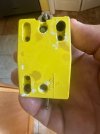
You could stop there but I drilled both holes out with a 1/4 bit then Dremel tool out the plastic over the screw. Have a nice oval opening over the screw. Separated the #4 wire strands into a "Y", tinned them and pushed them in around screw. Clamped down.
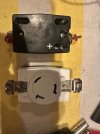
Only thing I didn't like was the #4 wire makes it hard to get the receptacle back in the box. Next time around I'll splice a pair of 12" #6 wire to the #4 cable run and come into the box. The #6 wire will go directly into the 1/4" drilled out holes without a Dremel too job.
The Hubble HBL328DCR receptacle accepts single 10AWG wire. It was drilled out side opposite #10 hole with 1/4" drill. They trimmed the #4 wire and jammed it into the hole. It worked but was a hack.

You could stop there but I drilled both holes out with a 1/4 bit then Dremel tool out the plastic over the screw. Have a nice oval opening over the screw. Separated the #4 wire strands into a "Y", tinned them and pushed them in around screw. Clamped down.

Only thing I didn't like was the #4 wire makes it hard to get the receptacle back in the box. Next time around I'll splice a pair of 12" #6 wire to the #4 cable run and come into the box. The #6 wire will go directly into the 1/4" drilled out holes without a Dremel too job.
The fact that the receptacle doesn't accept the thicker gauge wires also means that it isn't rated for the max current carrying capacity that those wires could carry.. If 4G was needed to meet the requirements for current demands, let's say multiple loads, but an individual load would be satisfied by a smaller wire gauge then a buss bar or fuse block type of intermediate distribution point would have been appropriate.
Hookup1
GreatGrady Captain
- Joined
- Oct 16, 2007
- Messages
- 3,577
- Reaction score
- 1,012
- Points
- 113
- Age
- 71
- Location
- Cape May, NJ
- Model
- Islander
Did your receptacle accept the #4 wire you ran?The fact that the receptacle doesn't accept the thicker gauge wires also means that it isn't rated for the max current carrying capacity that those wires could carry.. If 4G was needed to meet the requirements for current demands, let's say multiple loads, but an individual load would be satisfied by a smaller wire gauge then a buss bar or fuse block type of intermediate distribution point would have been appropriate.
It true that the receptacle/plug are only rated at x-amps. Because of the length of the wire runs they are upsized. Nothing wrong with getting maximum copper contact on the terminal inside the receptacle. But you have to work at it.
Finest Kind
GreatGrady Captain
Bigger is always better.
This is what I bought.
This is what I bought.
Amazon.com : Ancor 114505 Tinned Copper Battery Cable, 2 AWG (32mm2), Red - 50ft : Boating Wire : Sports & Outdoors
Amazon.com : Ancor 114505 Tinned Copper Battery Cable, 2 AWG (32mm2), Red - 50ft : Boating Wire : Sports & Outdoors
www.amazon.com
Finest Kind
GreatGrady Captain
Besides going with 2 gauge wire as I posted above, if it is not too late, I would also strongly suggest you buy and install ONE 36V LiFePo4 battery instead of the 3x 12V wet cells.I am installing a RHODAN 36 volt trolling motor on the bow of my Glacier Bay cat. I am going to use 3x 12v flooded cell group 24 batteries. I want to locate them a little aft of midships so the cable run is about 14 feet. I would rather have a little extra length than have tight runs with no chance for rearranging things, so maybe 16 fee total. The specs call out 42 amps to achieve the full 120 pounds of thrust. I am wondering if #6 AWG is big enough? If I am off base here, please line me up.
The benefits are:
Not a huge difference in cost for 1 36v batteriy vs 3 12v batteries.
(see my post for what I bought, but prices have come down quite a bit since i bought mine in Nov 2023)
Less weight in your boat.
Less space needed.
The ability to monitor the battery charge and battery performance from your cell phone LIVE on your boat as you use it through an app that connects via bluetooth directly to the BMS (battery management system) on the LiFePo4 battery.
Longer USABLE run time. These LiFePo4 batteies will continue to put out the full 36 volts as they deplete all the way down, while the lead-acid batteries will put out reduced voltage as they discharge, making your Rhodan totally not usable once they drop below 50% charge due to insufficient voltage.
Check out my install post here for more details.
Recently completed installation of my new Rhodan 96" shaft trolling motor on my classic Grady...the spot lock feature is a game changer!
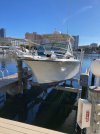
96" Rhodan on custom fabricated aluminum packing plate.
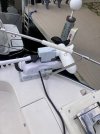
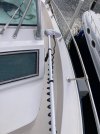
Losiggy 36 volt 100 amp Lithium Iron Phosphate (LiFePo4) battery mounted in stbd under bunk compartment.
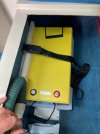
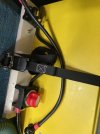
2 gauge wire run through anchor locker and attached to Battery Tender trolling motor connector

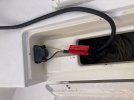
All I need now is free time to use the boat and cooperating sea conditions to occur at the same time!

96" Rhodan on custom fabricated aluminum packing plate.


Losiggy 36 volt 100 amp Lithium Iron Phosphate (LiFePo4) battery mounted in stbd under bunk compartment.


2 gauge wire run through anchor locker and attached to Battery Tender trolling motor connector


All I need now is free time to use the boat and cooperating sea conditions to occur at the same time!
- Finest Kind
- Replies: 8
- Forum: Tips, Modifications and Electronics
Last edited:
Thanks for the heads up. I have not purchased the batteries yet. I have received a NOCO 3 leg 12 volt charger but I haven't unwrapped it yet so I can return it. The battery you pointed me to weighs 66 pounds where the 3 12 volt DC would be 150 pounds. Thats huge when you consider there is no water levels to check in a difficult location. I figured out the cost and its only a little over a hundred bucks difference for the battery you recommended so I am going to go that route. I have had to put this project on the back burner because I had promised the dear wife, I would re-sod the yard and she was holding me to it. Luckily it delayed me enough that I can make the Lithium upgrade. Thanks again.
Hookup1
GreatGrady Captain
- Joined
- Oct 16, 2007
- Messages
- 3,577
- Reaction score
- 1,012
- Points
- 113
- Age
- 71
- Location
- Cape May, NJ
- Model
- Islander
Smart move. Lighter weight. The other consideration with the other batteries is that they would have to be AGM's. Regular batteries would out-gas and create an explosion hazard if they were mounted in a interior compartment.
Yes, and that off-gassing consideration is what made me decide to locate them where it was taking up some good storage space. The single 36v batt will make it unnecessary to make those jumper cables also.Smart move. Lighter weight. The other consideration with the other batteries is that they would have to be AGM's. Regular batteries would out-gas and create an explosion hazard if they were mounted in a interior compartment.

